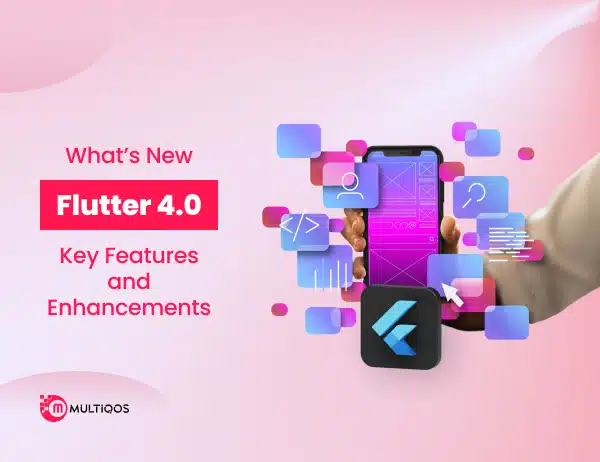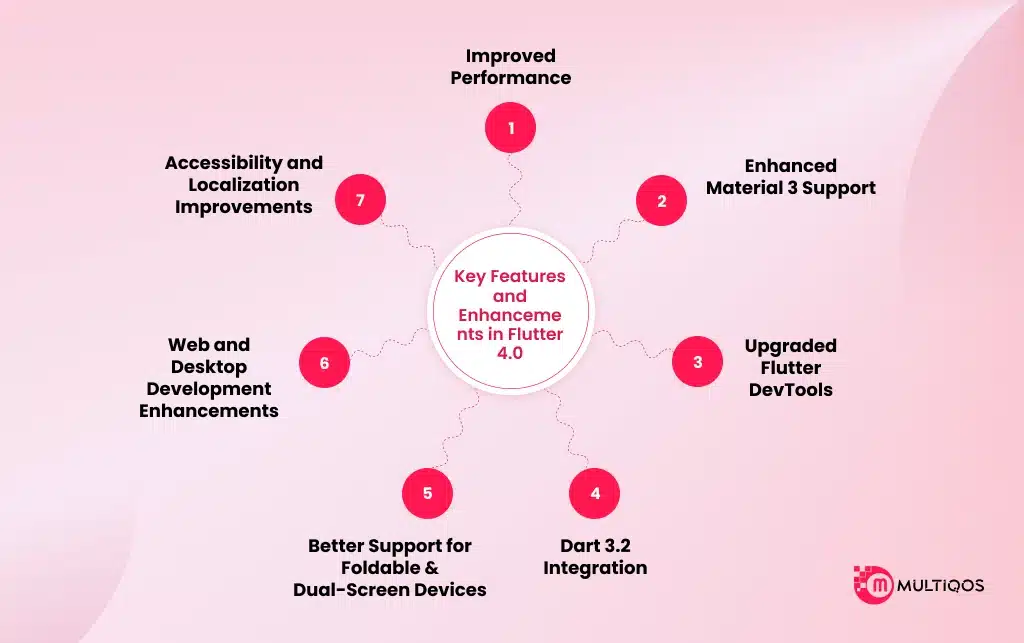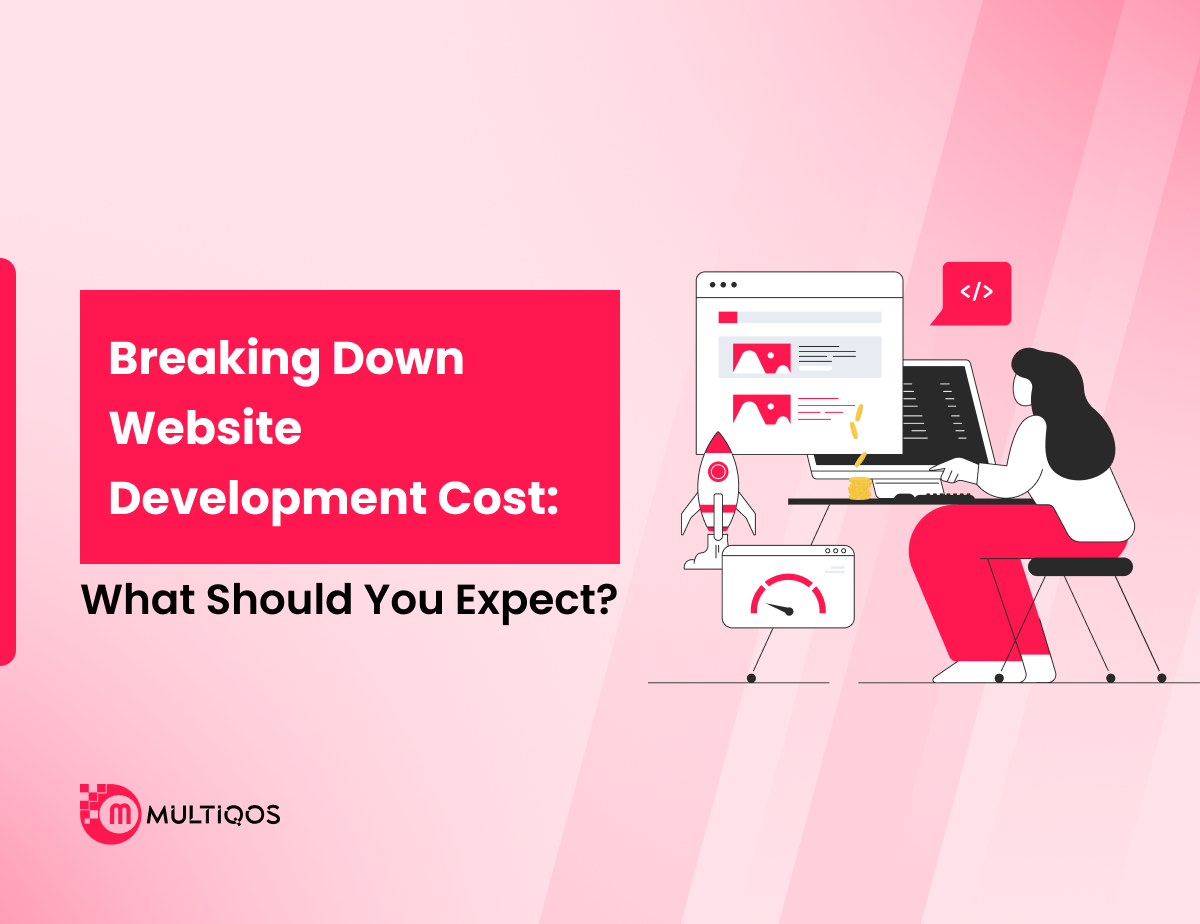What’s New in Flutter 4.0: Key Features and Enhancements

Summary:
Flutter 4.0 is a significant step forward in cross-platform development, bringing a range of improvements that enhance both the developer experience and end-user performance. This release focuses on streamlining the development process with a more consistent UI framework, improved tooling, and broader platform support.
Developers can expect smoother performance, better integration capabilities, and enhanced flexibility when building mobile, web, and desktop apps. This blog will explore the latest features and enhancements introduced in Flutter 4.0.
Introduction
Flutter is one of the most widely used cross-platform frameworks designed for developing stunning mobile, web, and desktop applications with a single codebase. With cross-platform tools, Google seems to push the boundaries of development in addition to features, performing upgrades and enhancements with the new tooling release of 4.0, which was launched in 2025.
If you are still trying out the capabilities of Flutter or you are a long-term user, each update is useful in optimizing your workflows and enhancing your app experience. In this blog, we’ll take a closer look at what’s new in Flutter 4.0 and assess changes that will improve your development activities.
Key Features and Enhancements in Flutter 4.0
The upcoming Flutter 4.0 update addresses designs to enhance performance, polish the user experience and simplify the developer experience. From mobile to web to desktop, this version includes everything needed to enhance cross-platform application development. The following are the new highlights:
1. Improved Performance
Performance has always been a key strength of Flutter, and it has only improved with version 4.0. With less shader compilation jank, smoother animations, faster UI rendering, app responsiveness, and overall responsiveness have improved. Most notably on mid-range and low-end devices, the experience feels much improved.
The engine now optimizes memory and background task management, improving battery life and overall user experience stability. With these changes, the scalability of applications has enhanced significantly, particularly those with a heavy UI or those that change frequently.
2. Enhanced Material 3 Support
With Flutter 4.0, developers have completed the shift to full Material 3 support, which now offers them more freedom to design sleek and modern apps. Navigation menus, buttons, and even input fields are now responsive to system changes regarding dynamic theming and coloring.
Material You principles permit the customization of interfaces while maintaining structural uniformity, therefore aiding the personalization efforts. This eases the challenge of providing sophisticated, branded user experiences and seamless native apps that integrate with the new Android design language.
3. Upgraded Flutter DevTools
The Flutter DevTools suite has been updated to provide an easier and more intuitive understanding of how apps function in real-time. With more advanced profiling tools, developers can now monitor layout problems, widget rebuilds, and even identify performance bottlenecks much more easily.
The user interface debugger has been improved with additional markers that assist users in identifying excessive renders or misalignment more easily. These improvements enable users to reduce the time spent on debugging while enabling teams to ship at a faster pace and with more confidence.
4. Dart 3.2 Integration
Flutter 4.0’s new features are integrated with Dart 3.2. This allows developers to write cleaner and more maintainable code. Dart 3.2 also comes with additional expressive features such as pattern matching, improved null safety, and more. All these features further decrease verbosity and assist with more easily readable logic flow, especially with handling real-time data or network calls.
The combination of both Flutter and Dart in this release assists developers in writing faster, more reliable, and efficient code with edge-case problems.
5. Better Support for Foldable & Dual-Screen Devices
With the growing adoption of foldable phones and dual-screen devices, Flutter 4.0 makes certain that developers are prepared to cater to them. Further improving APIs and layout elements allows apps to respond adaptively to specific changes like unfolding a device or Multi-Window mode. This facilitates the implementation of dynamic, seamless designs that span all contemporary hardware.
6. Web and Desktop Development Enhancements
With the release of version 4.0, Flutter further streamlines web and desktop applications, continuing its effort to unify app development across platforms. Rendering in web build is also more uniform and performs better with animations, scrolling, and font rendering, particularly on desktop computers.
Mouse and keyboard input have been improved, including smoother resizing of the windows and greater integration with the operating system. These enhancements ease the burden for developers building applications across multiple platforms and enable Flutter applications to be more responsive in their operations on different devices.
7. Accessibility and Localization Improvements
With Flutter 4.0, creating inclusive applications is easier than it has ever been. Enhancements have been made to accessibility features such as support for screen readers, touch exploration, and high contrast modes.
Widgets are more accessible by default, which minimizes the effort needed to ensure accessibility. Regarding localization, developers can now take advantage of improved processes for translating and culturally tailoring content and UIs, which helps global adoption of the applications.
What Makes Flutter 4.0 a Game-Changer for Developers?
For those aiming to develop applications that are scalable, fast, and good-looking over multiple platforms, Flutter 4.0 is the absolute gold standard. With deeper integration with Dart 3.2, broadened Material 3 support, and performance enhancements, many of the issues developers faced in previous versions have been resolved in this iteration of Flutter.
The numerous additions in project stability are complemented by a reduction in development time because streamlined workflows make debugging, thanks to improved DevTools, more intuitive.
With this update, everyone who is into Flutter app development gets new opportunities, especially with regard to foldable devices, desktops, or web builds. Enhanced accessibility tools and localization features also aid in reaching new markets more inclusively.
Whether starting fresh or updating from an earlier version, all tools and performance in Flutter 4.0 ensure a competitive edge in today’s rapidly evolving environment.
Wrapping Up
In cross-platform development, Flutter 4.0 is a huge improvement because it adds new functionalities and optimizes the ones that were already present. Improvements to performance, UI consistency, enhanced tools, support for more platforms, extensibility, and new features were added. Because of these additions, new experiences will improve user satisfaction and streamline complex processes.
Startups and businesses tend to embrace frameworks that support digital products, and with Flutter maturing more and more, it enables the use of adaptable UIs and consistent cross-platform services. If you are thinking of developing an application or have a project that needs scaling and optimization, the latest release gives enough reasons to hire Flutter app developers to bring the project’s ideas to life.
FAQs
The latest version of Google’s open-source UI framework is Flutter 4.0 which will be released in 2025. Google designed the framework with the intention of building natively compiled applications for mobile, web, and desktop using a single codebase. The new updates will include performance, UI components, and developer tools.
Optimized performance, wider support for Material 3, improved tooling capabilities via Flutter DevTools, enhanced integration with Dart 3.2, and added support for foldable devices along with increased capabilities for desktop and web platforms are some of the highlighted improvements.
Yes, Flutter 4.0 is for the most part backward compatible. However, if you wish to use the new features, then some migration steps will be required based on your current dependencies.
Updating to Flutter 4.0 supports modern UI features as well as broader device compatibility while also improving performance, development tools, and device support which increases the robustness of apps developed on the platform and the speeds at which they can be developed.
Absolutely. Flutter 4.0 is enhanced for application development of any scale on mobile devices, the web, and desktops. As of 2025, modern app development will be further advanced owing to Flutter’s improved stability, upgraded UI toolkit, and strong community support.
Get In Touch







